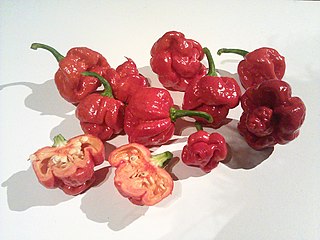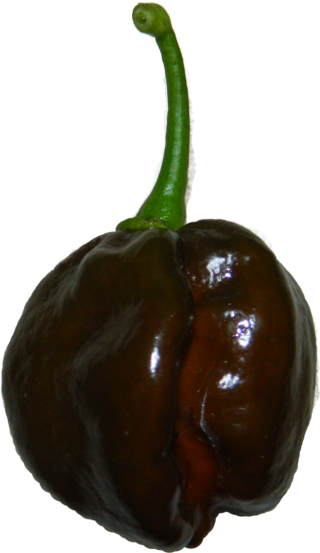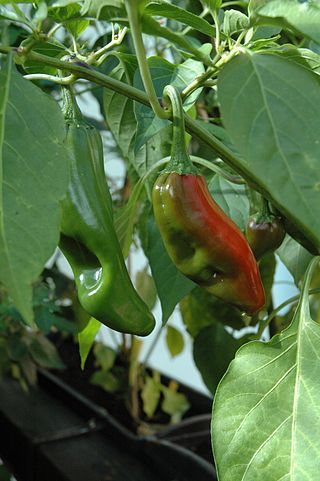
The Scoville scale is a measurement of pungency of chili peppers and other substances, recorded in Scoville heat units (SHU). It is based on the concentration of capsaicinoids, among which capsaicin is the predominant component.

Chili peppers, from Nahuatl chīlli, are varieties of the berry-fruit of plants from the genus Capsicum, which are members of the nightshade family Solanaceae, cultivated for their pungency. Chili peppers are widely used in many cuisines as a spice to add "heat" to dishes. Capsaicin and related compounds known as capsaicinoids are the substances giving chili peppers their intensity when ingested or applied topically. Chili peppers exhibit a wide range of heat and flavor profiles. This diversity is the reason behind the availability of different types of paprika and chili powder, each offering its distinctive taste and heat level.

Hot sauce is a type of condiment, seasoning, or salsa made from chili peppers and other ingredients. Many commercial varieties of mass-produced hot sauce exist.

Capsicum chinense, commonly known as a "habanero-type pepper", is a species of chili pepper native to the Americas. C. chinense varieties are well known for their unique flavors and many have exceptional heat. The hottest peppers in the world are members of this species, with a Scoville Heat Unit score of 2.69 million measured in the C. chinense cultivar, Pepper X in 2023.
A chili grenade is a type of non-lethal weapon developed by Indian military scientists at the Defence Research and Development Organisation for use by the Indian Armed Forces. The weapon is similar to tear gas. In 2016, civilian variants were being used for crowd control in Jammu and Kashmir.

The Naga Viper pepper is a hot chili pepper. In 2011, it was recorded as the "World's Hottest Chili" by the Guinness World Records with a rating of 1,382,118 Scoville heat units (SHU), but was surpassed in SHU by the Carolina Reaper, in 2017, and again by the latest world record holder Pepper X in 2023.
The Infinity Chili pepper is a chili pepper hybrid of the Capsicum chinense species created in England by chili breeder Nicholas Woods of Fire Foods, Grantham, Lincolnshire. For two weeks in February 2011, the Infinity Chili held the Guinness World Record title for the world's hottest chili with a Scoville scale rating of 1,067,286 Scoville Heat Units (SHU). On March 1, 2011, it was displaced by the Trinidad Scorpion Butch T pepper, which registered 1,463,700 SHU.

The Trinidad Moruga scorpion is a chili pepper native to the village of Moruga, Trinidad and Tobago. In 2012, New Mexico State University's Chile Pepper Institute identified the Trinidad Moruga scorpion as the hottest chili at that time, with heat of 1.2 million Scoville heat units (SHUs).
The Chile Pepper Institute at New Mexico State University in Las Cruces, New Mexico, is an international research-based and non-profit organization specializing in research, education and archiving information related to Capsicum or chile peppers. The institute was established in 1992 and is devoted to research and educating the world about chile peppers. Its research facility is named for Fabián García, a Mexican-American horticulturalist dubbed "the father of the U.S. chile pepper industry", who began standardizing varieties of chile pepper in 1888.

The Carolina Reaper chili pepper is a cultivar of the Capsicum chinense plant. Developed by American breeder Ed Currie, the pepper is red and gnarled, with a bumpy texture and small pointed tail. It was the hottest chili pepper in the world according to Guinness World Records from 2013 to 2023 before it was surpassed by Pepper X, which was also developed by Currie.

The ghost pepper, also known as bhut jolokia, is an interspecific hybrid chili pepper cultivated in Northeast India. It is a hybrid of Capsicum chinense and Capsicum frutescens.

The Chocolate Habanero pepper is a cultivar of the habanero chili, which has been selectively bred to produce spicier, heavier, and larger fruit, ultimately more potent than its derivative.

Capsicum is a genus of flowering plants in the nightshade family Solanaceae, native to the Americas, cultivated worldwide for their chili pepper or bell pepper fruit.

The habanero is a hot variety of chili. Unripe habaneros are green, and they color as they mature. The most common color variants are orange and red, but the fruit may also be white, brown, yellow, green, or purple. Typically, a ripe habanero is 2–6 centimetres long. Habanero chilis are very hot, rated 100,000–350,000 on the Scoville scale. The habanero's heat, flavor, and floral aroma make it a popular ingredient in hot sauces and other spicy foods.
Dragon's Breath is a chili pepper cultivar that unofficially tested at 2.48 million Scoville units.

Pepper X is a cultivar of Capsicum chili pepper bred by Ed Currie, creator of the Carolina Reaper. Pepper X resulted from several cross breedings that produced an exceptionally high content of capsaicin in the locules of the pepper. The exceptional pungency of the chili was developed over 10 years of cultivation.

Especially among growers in the US, the UK, and Australia, there has been a competition since the 1990s to grow the hottest chili pepper. Chili pepper species and cultivars registering over 1,000,000 Scoville Heat units (SHU) are called "super-hots". Past Guinness World Record holders include the ghost pepper, Infinity chili, Trinidad Moruga scorpion, Naga Viper pepper, Trinidad Scorpion Butch T, and Carolina Reaper. The current record holder, declared in 2023, is Pepper X, at more than 2.69 million SHU.

The Big Jim pepper is a New Mexico chile pepper cultivar of the species Capsicum annuum with a Scoville rating of mild. This cultivar is extensively grown in New Mexico where it was developed and is popular in New Mexican cuisine. Big Jim peppers are both sweet and mild and are normally picked while still green. The fruits are large and thick walled, often exceeding over a foot in length, and they are almost exclusively used to produce roasted green chile in New Mexican cuisine.

The Habanaga is a cultivar of the chili pepper Capsicum chinense. This pepper was developed in New Mexico when a university student unintentionally crossed a Habanero and a Bhut Jolokia.















